
At 33 years of age, I still count myself among the younger underwater photographers within the industry and yet I am gradually trying to move up into the professional field.
Living in the north of Germany, I work full-time as a professional firefighter and paramedic. I invest my free time in photography, mainly in the water, where I find the balance to the often stressful and hectic job.
Whether in the cold lakes at home with mostly miserable visibility or in the tropical seas with almost infinite visibility – no body of water is safe from me and my camera!
In 2015, a spontaneous holiday idea ended in my first certification as a scuba diver. Since then, I have steadily optimised my diving skills and gradually exchanged my hobby action camera for more professional equipment. Now I have been photographing more purposefully underwater for about five years.
After National Geographic Germany named me ‘Newcomer Underwater Photographer 2022’ last year, I took another step towards professionalism this year by working as a freelance photographer for Greenpeace.
It has become a matter of the heart to show my fellow men the beauty, uniqueness, and fragility of our oceans. To show them why exactly these ecosystems are so worth protecting and what special features lie right on our doorstep.
Although sharks are my absolute favourite motifs, every other motif appeals to me to a greater or lesser extent. Little by little, my hard drive filled up with countless pictures of nudibranchs, reef fish, sharks, rays, seahorses, corals, shrimps, turtles and other sea creatures. Even the local fish are not neglected in my portfolio, so the pictures of pike, perch and catfish are constantly piling up.
While I celebrated my first successes in underwater photography a few years ago with an Olympus TG5 and only one external flash, my setup has now grown considerably. Currently, I use a SONY Alpha 6400 in a Fantasea Housing with several different lenses (SONY 30mm f/3.5 macro, SONY 90mm f/2.8 macro and SIGMA 16mm f/1.4 wide-angle) in different dome ports.
Two INON z330s and two Weefine Smart Focus 3000s are used for targeted illumination of my subjects. The setup is rounded off by various brackets, clamps and floats.
Although I am already very satisfied with this combination, hopefully the upgrade to the SONY A7IV will follow soon, so I hope for better results, especially in areas with less ambient light.

Blue spotted stingray – taken with the SIGMA 16 mm in the Red Sea, Marsa Alam. I personally like the dynamics that this picture conveys.

Blue spotted stingray 2 – Taken with the SIGMA 16 mm in the Red Sea, Marsa Alam. This image is not cropped, and it was a real challenge to get so close to the animal with the wide-angle lens.
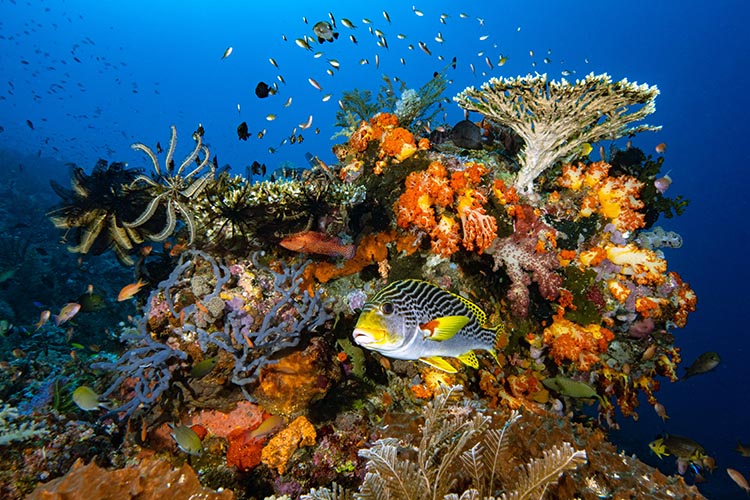
Coralreef – a typical reef scene as often found in Komodo National Park. I quite like the variety of colours, especially of the soft corals. Taken with the SIGMA 16 mm.

Coralreef 2 – at some dive sites in the Red Sea (Marsa Alam) you can find such beautifully overgrown underwater mountains, there is always something to discover here. Taken with the SIGMA 16 mm.

Dugong – What luck! Even though the dugong can still be frequently encountered in some bays in Egypt, these animals are usually besieged by divers and snorkellers. We were all the more delighted when we encountered this elegant animal on our first dive. And all alone. So, we had a good 15 minutes with this animal on the sea grass meadow in the Red Sea, south of Marsa Alam. Taken with the SIGMA 16 mm.
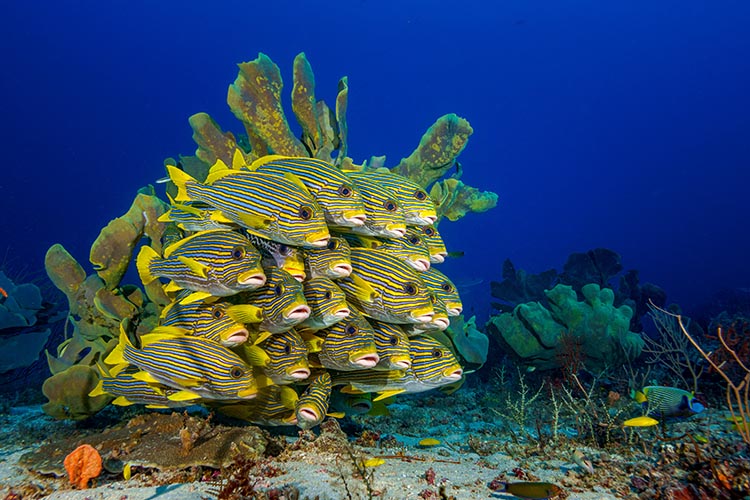
Fish – in the waters of Raja Ampat I was able to photograph this school of sweetlips. They are often found in coral-rich areas where during the day they often stand in front of protected reef blocks or other semi-protected areas like this sponge. A great photo motif and a typical image from Raja Ampat. Taken at about 30 metres depth with the SIGMA 16mm wide-angle lens.
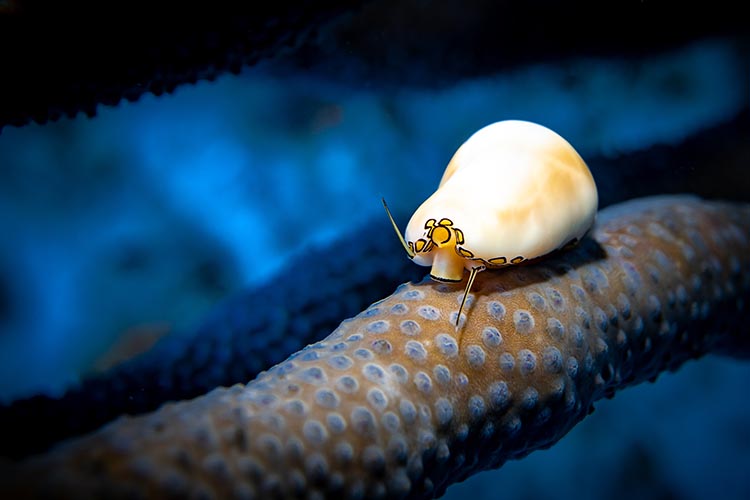
Flamingo tongue – a nyone who has dived in the Caribbean, especially Curacao, will know it: the Flamingo tongue. Most of the time you can already guess the tiny animals from the ice snail family by their feeding marks on the soft coral. I particularly like the lighting and the contrast with the blue background, as well as the exact focus point on the eye of the tiny sea dweller. Taken with the SONY 30mm macro lens.

Frogfish – a still young specimen of the warty frogfish which I was able to photograph this year in Tulamben, Bali. The juvenile can be easily recognised by its typical white ground colour with striking orange-red spots. This animal had a size of about 1.5 centimetres. Taken with the SONY 90mm macro lens.

Hawkfish – I just can’t manage to dive past them without photographing them. While they are still numerous in the Red Sea and other tropical seas, it is always a small highlight for me. Taken with the SONY 90mm macro lens.

Lionfish – there are countless snapshots of this animal, but I think mine stands out a bit from the others. This young lionfish was eyeing its reflection in my Domeport and I took advantage of the situation to snap this curious fish at just the right moment. In the background, the horizon of water and sand blurs almost inconspicuously but is still clearly visible. Taken with the SIGMA 16mm wide-angle lens in the Red Sea, Marsa Alam.
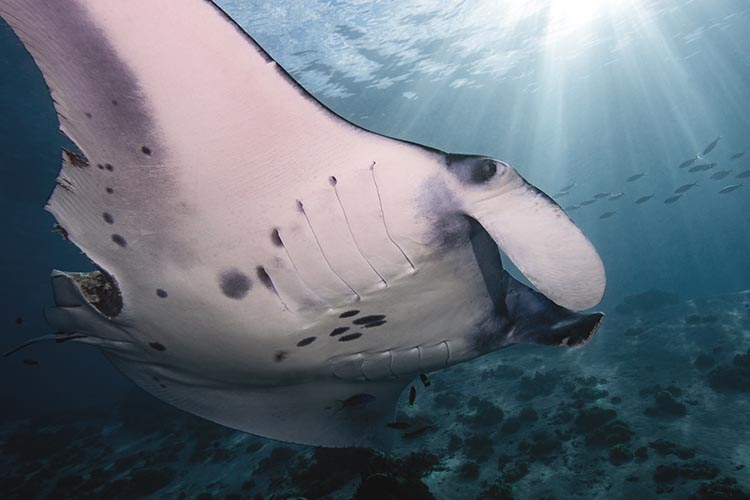
Manta – These majestic creatures float through the water almost like small aeroplanes and make every diver’s heartbeat faster. I have already encountered several manta rays, but this was by far the most beautiful moment for me. We met this manta ray at the end of a dive in Komodo National Park, but we were still able to spend a few fantastic minutes with him.
Again and again, he came within a few centimetres of me and blocked out the sun. Although he already had a severe bite wound, he was completely fearless towards us and even seemed to enjoy playing with the bubbles of exhaled air a bit. Taken with the SIGMA 16mm wide-angle lens.

Manti – taken in Tulamben, Bali. This little guy didn’t shy away from the limelight and eyed the huge camera warily with his myriad eyes. During this dive, some good pictures of this animal ended up on the hard drive, but I think this one is one of the best. Taken with the SONY 90mm macro lens.

Nemo – also from Tulamben, this picture was taken last year. Patience paid off and I managed to get two Nemo’s in the same pose one after the other. With an open aperture, the fish in the back is blurred while the one in front is in perfect focus. Taken with the SONY 90mm macro lens. This image has already earned me several placings in international photo competitions.
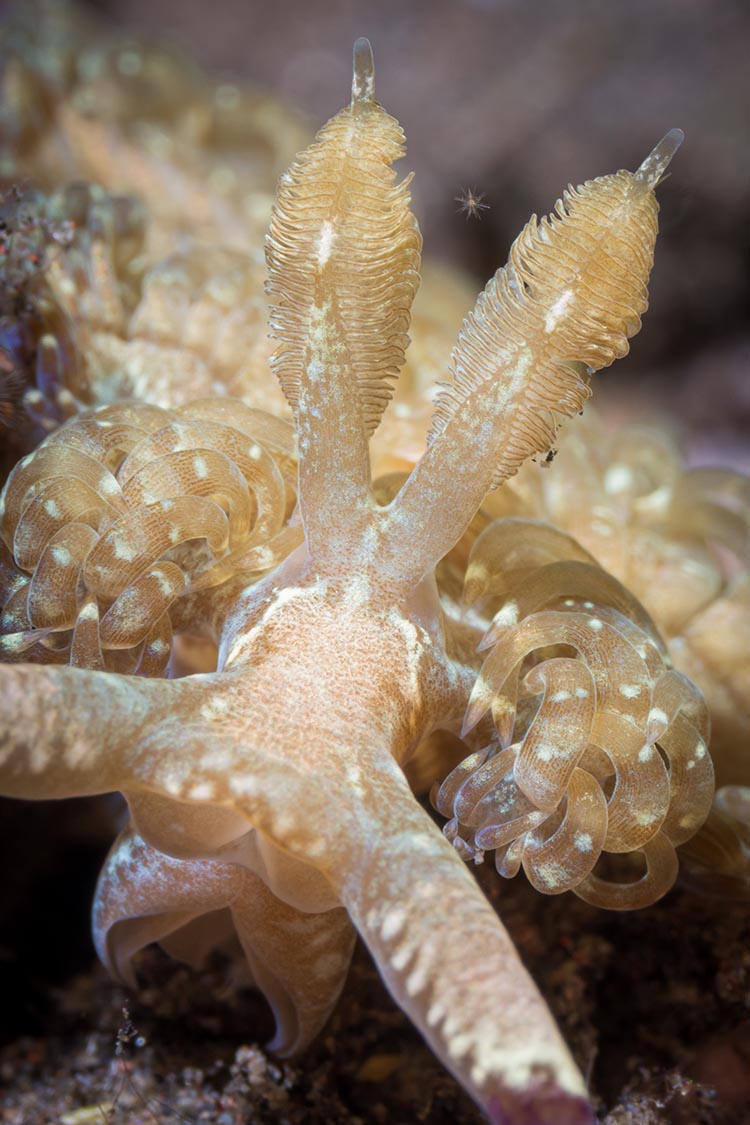
Nudibranch Plankton – it would be a bit of an exaggeration to say that this picture was intended to be this way. I certainly planned the composition of the picture with the view of the nudibranch, and I also intentionally placed the focal point on the two Rinophoren. But the small, star-shaped crown was definitely not planned, and I only discovered it after developing the files on the computer. Taken with the SONY 90mm macro lens in Tulamben, Bali.

Nudibranchias – taken in the Red Sea, Marsa Alam. It shows a Hypselodoris puchella. With its 8 – 11 cm size, this magnificent star snail already belongs to the larger Nudibranchias. Taken with the SONY 90mm macro lens.

Nudibranchia 2 – this picture also shows magnificent star snails, more precisely it shows two Hypselodoris tryoni. Often these animals are found in pairs, usually one snail follows the other. Therefore, I was very pleased to be able to photograph these two specimens in this joint pose. Taken with the SONY 90mm macro lens in Tulamben, Bali.
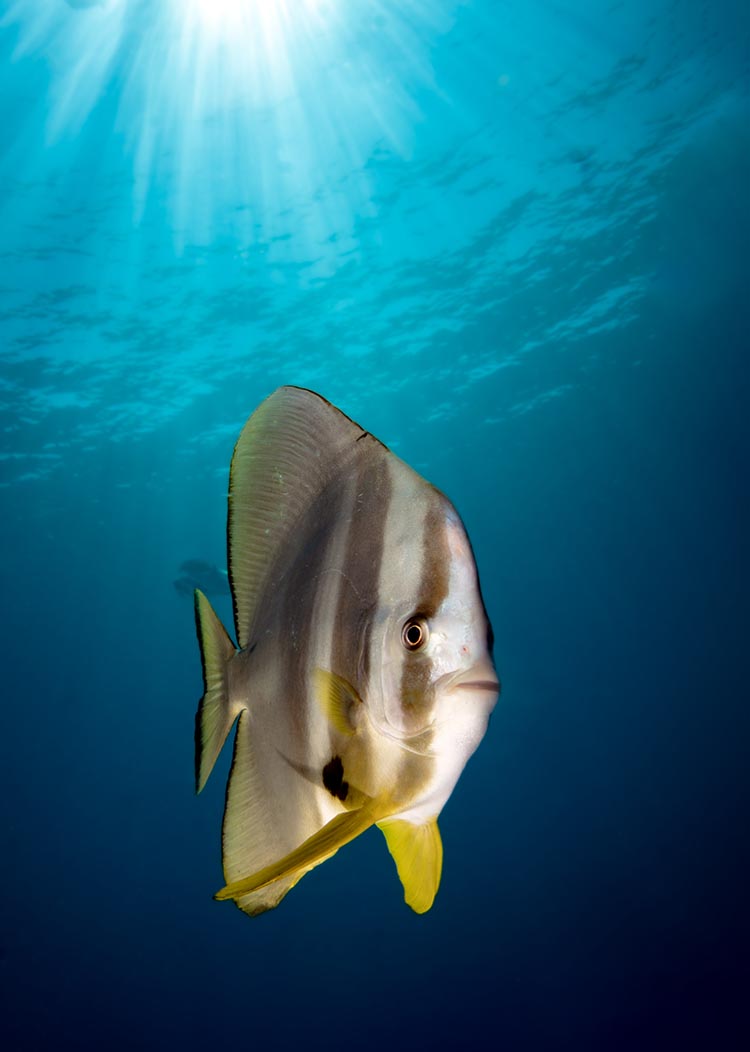
Platax – what a great image, tried many times but never got it right again. This batfish accompanied me during a safety stop in Komodo National Park and took a liking to playing with my bubbles. The already low sun combined with the shallow dive depth allowed me to capture this fish in such a brilliant pose with the great background. Taken with the SIGMA 16mm wide angle lens.

Seahorse – One of my first professional images. Taken in the Adriatic Sea off Croatia. I particularly like the dark background in contrast to the yellow seahorse, which is emphasised even more by the specific lighting. The animal’s shy look at the camera completes the picture. Taken with the SONY 30mm macro lens.
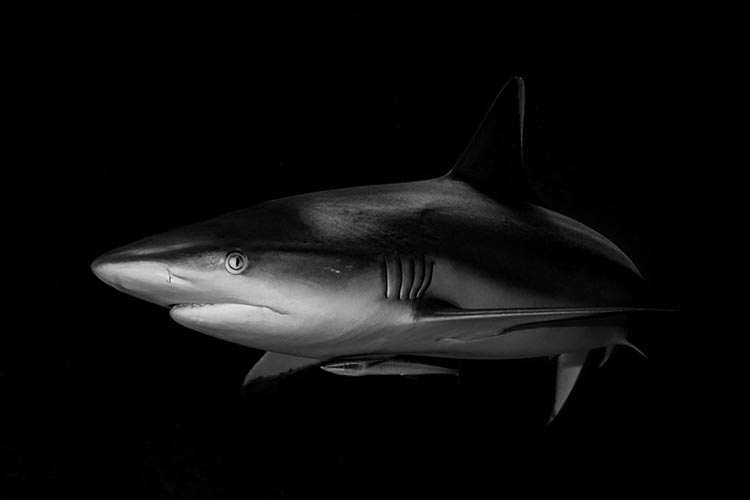
Shark – actually, it should not be missing in any portfolio of underwater photography and yet this animal presents every photographer with a challenge. The often-shy animals usually avoid the proximity to the photographer and at least I avoid the proximity to feed. I usually only see these elegant predators in the distance, so I enjoyed this encounter in the Maldives all the more when this young reef shark came within a few centimetres of me. As the background in this picture seemed very turbulent, I decided to develop this picture in black and white and I am more than satisfied with the result. Taken with the SIGMA 16mm wide-angle lens.
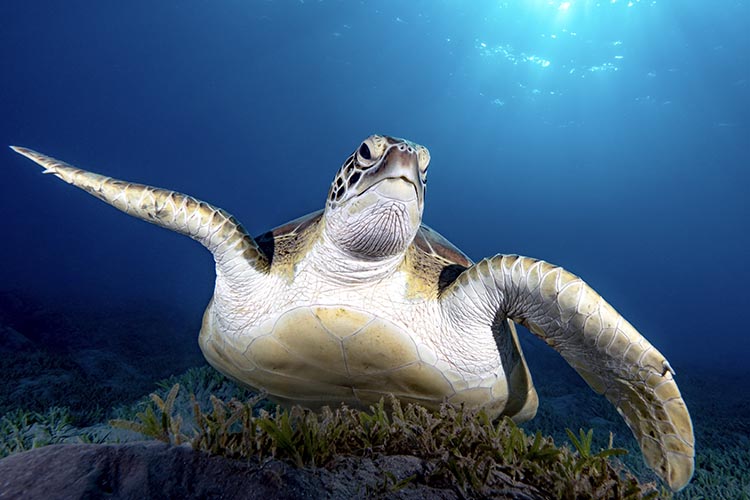
Turtle – sun, sea grass, and a turtle. It doesn’t take much more for a great picture from the Red Sea. If it looks so easy to photograph this animal, this picture demanded a lot from me. First, I needed a turtle that was not besieged by countless divers or snorkellers. I also needed the animal in the right position with the sun behind it and the right moment when the animal surfaces to swim to the surface to breathe. So, this picture took a good 50 minutes on a shallow seagrass meadow in the Red Sea and several a,empts until I had the result in the box. Taken with the SIGMA 16mm wide-angle lens.
If you’d like to know more about Jan, or discuss the purchase of some of his images, he can be reached via Instagram @blubber_jan
If you’d like to see your underwater photography published on these pages and shared across our social media feed and weekly newsletter, why not drop us a line at info@divemagazine.com.


